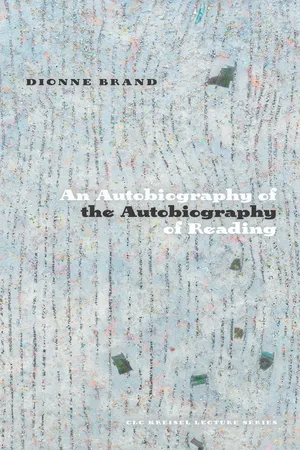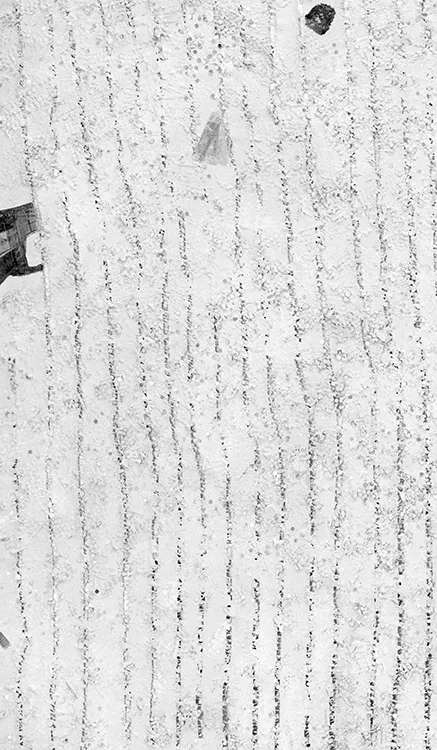
- 72 pages
- English
- ePUB (mobile friendly)
- Available on iOS & Android
eBook - ePub
An Autobiography of the Autobiography of Reading
About this book
The geopolitics of empire had already prepared me for this…coloniality constructs outsides and insides—worlds to be chosen, disturbed, interpreted, and navigated—in order to live something like a real self.
Internationally acclaimed poet and novelist Dionne Brand reflects on her early reading of colonial literature and how it makes Black being inanimate. She explores her encounters with colonial, imperialist, and racist tropes; the ways that practices of reading and writing are shaped by those narrative structures; and the challenges of writing a narrative of Black life that attends to its own expression and its own consciousness.
Frequently asked questions
Yes, you can cancel anytime from the Subscription tab in your account settings on the Perlego website. Your subscription will stay active until the end of your current billing period. Learn how to cancel your subscription.
No, books cannot be downloaded as external files, such as PDFs, for use outside of Perlego. However, you can download books within the Perlego app for offline reading on mobile or tablet. Learn more here.
Perlego offers two plans: Essential and Complete
- Essential is ideal for learners and professionals who enjoy exploring a wide range of subjects. Access the Essential Library with 800,000+ trusted titles and best-sellers across business, personal growth, and the humanities. Includes unlimited reading time and Standard Read Aloud voice.
- Complete: Perfect for advanced learners and researchers needing full, unrestricted access. Unlock 1.4M+ books across hundreds of subjects, including academic and specialized titles. The Complete Plan also includes advanced features like Premium Read Aloud and Research Assistant.
We are an online textbook subscription service, where you can get access to an entire online library for less than the price of a single book per month. With over 1 million books across 1000+ topics, we’ve got you covered! Learn more here.
Look out for the read-aloud symbol on your next book to see if you can listen to it. The read-aloud tool reads text aloud for you, highlighting the text as it is being read. You can pause it, speed it up and slow it down. Learn more here.
Yes! You can use the Perlego app on both iOS or Android devices to read anytime, anywhere — even offline. Perfect for commutes or when you’re on the go.
Please note we cannot support devices running on iOS 13 and Android 7 or earlier. Learn more about using the app.
Please note we cannot support devices running on iOS 13 and Android 7 or earlier. Learn more about using the app.
Yes, you can access An Autobiography of the Autobiography of Reading by Dionne Brand in PDF and/or ePUB format, as well as other popular books in Literature & Literary Criticism for Women Authors. We have over one million books available in our catalogue for you to explore.
Information

THERE IS A PHOTOGRAPH of me taken when I was a child. I do not recognize myself, though I seem to remember the day and the event. The little girl, reputed to be me, in the photograph is about three or four years old. It is the earliest and only photograph of this period. They say that I am one of the four children in this photograph; the three others are my sisters and my closest cousin. I recognize them. We are four girls. I am alleged to be second from the left, third from the right. We all have white ribbons in our hair. We are taking a photograph to send to England to my mother and her younger sister, who are in England becoming nurses. Several years before, they had left by boat, by ship, perhaps a Cunard ship, whose name my aunt does not recall now, though she does recall passing Tenerife, standing on deck—thinking that one day she would like to go back there. She says this with the same longing as then. They arrived at the port of Southampton, my aunt and my mother, sometime in 1956. From Southampton they took a boat-train to London, where they were gathered by the hospital they were assigned to. This boat-train I meet later in the wonderful first sentence of Samuel Selvon’s novel The Lonely Londoners:
One grim winter evening, when it had a kind of unrealness about London, with a fog sleeping restlessly over the city and the lights showing in the blur as if is not London at all but some strange place on another planet, Moses Aloetta hop on a number 46 bus at the corner of Chepstow Road and Westbourne Grove to go to Waterloo to meet a fellar who was coming from Trinidad on the boat-train.1
I imagine that my mother and my aunt encounter this same London as described by Selvon. When we take the photograph, we are taking it to send to my mother and my aunt, but also to send to England. England is in the air at home. It is referred to with reverence as “away” or “abroad.” England is as much the spectator; and for England, standing behind my mother and my aunt, we must make a good appearance. They arrived in London under the impression that they, too, had to make a good appearance, so that they and we would be accepted and acceptable. I am, to my mind, the most active in the photograph, helping the photographer to make the photograph right. I remember my younger sister and cousin crying and the photographer, Mr. Wong, assigning me to distract them with a toy rattle. I take my job seriously. Now, it seems mechanically. My mother and my aunt have left under the impression that they, too, must make a good appearance. We must look out into the camera, Mr. Wong says, “Little girls, smile! Don’t cry.” I recall trying to follow his instruction; my little sister is crying, and my cousin is trembling in sympathy. My older sister is aloof with her own self-arrangement. I remember all of these actions, but I do not recognize the girl who is me in the photograph. Whoever I appear to be is simply that: an appearance. As when you come upon a figure across a street in a glass-walled building. Yet even more remote than this. I cannot even make out a gestural similarity. Except for my older sister, we three youngest do not remember my mother and my aunt. We only know of them from stories, from the frequent invocation of their names in the house where we live. My mother and my aunt are in the imagination and so, too, is England, where they now live and where they are said to be getting along. We are all tied to England, and England to the imagination. All letters after—all communication of information, endearment, and entreaty—will go to and arrive from Wandle Valley Hospital, Mitcham Junction, Surrey, England. Sixty years later my older sister will still remember this address by heart. And all the letters, back and forth, will begin with this courtesy: Dear _____, Hope you are well and enjoying the best of health. England will be the recipient, the audience. England is a better place. Our lives will revolve around and be decided in the letters sent and received.
Everyone says the little girl looks like me. I doubt it. I do not recognize myself. Already I am changed in the photograph, since I leave off being myself to follow the directive of the photographer; already I have changed, thinking of composing myself, for the audience. I now recognize myself as authored, altered. As selected, sorted, from a series of selves for appearance and presentation. All photographs are like this, of course. One is conscious or anxious or confident or deliberate in striking an appearance that must keep, must transmit one’s meaning—or the photographer’s meaning. That is the studium, as Barthes describes in Camera Lucida—and that photograph is supposed to reach its viewers and reassure them. And it probably does. Though we, we are without conscious meaning, which is why we are crying or aloof or attentive to the photographer—and that is the punctum. The photograph or the job the photographer must do is disrupted by the indecorousness of some of the subjects, the disparate attitudes of the little girls who, despite being told of the importance and expense of the occasion of the photograph, respond in wholly individual ways. They do not even mean to disrupt; they have been warned not to be ill-behaved, as I recall. But they’ve panicked in the face of these disciplines. The stranger who is the photographer, the new linoleum smell of the room where the photograph is being taken, the tripod, the camera, the warning to behave, and the shy desire to have themselves be seen by the mother and the aunt in England. Ultimately, the photograph can’t do all the work it is required to do—the photograph does produce them—but they are in the middle of being something—still pliable, permeable—you can see all that in the photograph—and that disrupts the work the photo is being sent out to do—they are/we are not properly composed. The photo also perhaps confirms the disciplining work to be done. Despite Mr. Wong’s arrangement of us by height, despite his angles and the curtain behind and the linoleum floor composition, the photo cannot hold the girls in. And perhaps we will remain in this liminal space between photograph and meaning—permeable. But perhaps not.
The permeability evident in the photograph will yield to instruction from here on—instruction that also arrives from English schoolbooks, English academic testing, English literature that a colonial apparatus provides. I will go on to Miss Greenidge’s Dame School, I will go on to the San Fernando Girls English Catholic School, I will go on to the Naparima Girls’ High School, sending letters and receiving instructions from England; from Surrey, then from Croyden, then from “Pip and the Convict,” “Dick Whittington and His Cat,” “Bobby Shafto’s Gone to Sea,” “To a Butterfly,” “Oh Mary, go and call the cattle home…across the sands o’Dee”—becoming, becoming the representation of the self, signified by the opportunity of the photographic event.
A photograph. A portrait, desired, settled, and puncturing the frame of the photograph. All the relations that come together to make the portrait—the children, the mother, and the aunt waiting for the photograph, the adult outside of the frame who brou...
Table of contents
- Cover
- Title Page
- Copyright Page
- Foreword
- Liminaire
- Chapter 1
- Chapter 2
- Chapter 3
- Chapter 4
- Chapter 5
- Notes
- About the Author
- CLC Kreisel Lecture Series